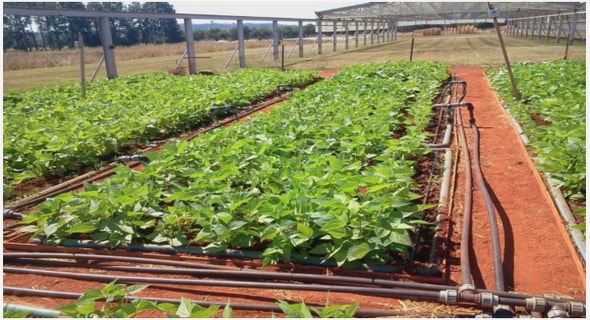Get Complete Project Material File(s) Now! »
Stomatal conductance approach
Stomatal conductance is most often described using mathematical expressions, which represent physical and physiological characteristics of the biological process being 47 studied (Damour et al. 2010). The most common models fall within two main categories, namely: (1) models applied at the leaf level, which include multiplicative models of environmental influences and models of stomatal behaviour; (2) models applied at the canopy level, which include those that are based on the PenmanMonteith resistance model (Leuning, 1990; Leuning, 1995; Rana and Katerji, 2000; Pereira et al. 2006; Damour et al. 2010). In both categories of models, stomatal conductance is estimated taking into account both canopy properties and meteorological conditions. Models applied at the leaf level may not be able to provide accurate estimations of T for an entire canopy due to the fact that changes in stomatal conductance are highly variable: (1) at the leaf level, due to changes in stomatal characteristics (stomatal density and pore length).
DESCRIPTION OF EXPERIMENTAL SITES
Field experiments for research in pecan trees were conducted in Cullinan (25° 35’ 20.65’’ S and 28° 33’ 31.90’’ E; approximately 1340 masl) and on the University of Pretoria’s Hatfield Experimental Farm (25° 44’ 55.88’’ S and 28° 16’ 22.96’’ E; approximately 1370 masl), Gauteng province. Research trials in macadamia trees were conducted in White River (25° 21′ 32.80″ S and 31° 3′ 34.44″ E; approximately 765 masl), Mpumalanga province. All experimental sites were located within the summer rainfall area of South Africa. A detailed description of each experimental site is presented below.
White River experimental site
The climate of the study site in White River is humid subtropical, with mean daily temperatures varying between 4.2 and 29.1 °C and an average annual rainfall of 722 mm (Schulze and Lynch, 2007). Field measurements in White River were conducted in a bearing ‘Beaumont’ macadamia orchard (Macadamia integrifolia X Macadamia tetraphylla) planted in 2005 on ‘Beaumont’ rootstock from October 2010 to October 2012 (Figure 3.3). Trees were arranged in hedgerows, with an 8 m x 4 m spacing (32 m2 per tree) in a 34 ha block.
Tree row orientation was along a N to S axis. The orchard 57 was irrigated using two drip lines per tree row, with drippers spaced 1.0 m apart and a delivery rate of 1.8 L.h-1 , resulting in a wetted diameter of 1.0 – 1.6 m per dripper. Irrigation was typically scheduled three to five times per day, almost every day (increasing from winter to summer). The average tree height throughout the measurement period was 5.0 m, with the average trunk diameter at 0.5 m increasing from 0.118 to 0.123 m over the two-year trial period. Average yield increased from 4.8 t ha-1 in-shell in 2010/2011 season to 6.0 t ha-1 in-shell in the 2011/2012 season. Trees were pruned to a modified central leader prior to the start of each season. The soil type was sandy loam to sandy clay loam. Inorganic fertigation was performed based on soil and leaf analyses.
Meteorological measurements
Daily reference evapotranspiration (ETo) and vapour pressure deficit (VPD) for the measurement period were calculated using the procedure described in FAO-56 (Allen et al. 1998) from weather data obtained from an automatic weather station (AWS) located on each farm, within 500 to 800 m of the orchards. The weather parameters recorded were wind speed, solar radiation, temperature, relative humidity and rainfall. Quality assessment and quality control of weather data obtained from all the AWS was performed according to the procedures described by Allen (2008).
Irrigation scheduling monitoring
In the pecan orchard, irrigation was typically scheduled once every six days for 24 hours (equivalent to 31 mm) and was recorded using an in-line electrode and water meters, which were read every 2 weeks, while in the macadamia orchard it was typically scheduled three to five times per day, almost every day (increasing from winter to summer). Irrigation scheduling was monitored through soil water content measurements using a Time-Domain Reflectometry system. The allowable depletion was kept between 0 – 20% of plant available water throughout the experimental period. Seasonal cumulative water supply (irrigation plus rainfall) was above the atmospheric evaporative demand (represented by ETo) and crop evapotranspiration in both experimental sites, as observed in Figures 3.9 for the 37-year-old pecan orchard during the 2011/12 season at Cullinan and 3.10 for the 6-year-old macadamia orchard during the 2011/12 season at White River.
Crop evapotranspiration measurements
An extended Open Path Eddy Covariance (OPEC) system (Campbell Scientific Inc., Logan, UT, USA) was installed in the pecan orchard at the Cullinan experimental site, at 1.5 m above the 14.5 m tall trees (Figure 3.11A) and in the macadamia orchard in White River at 1.2 m above the 5.0 m tall trees (Figure 3.11B). Micrometeorological variables measured included latent (λE), sensible heat (H) and soil heat (G) fluxes. These measurements were conducted for 32 consecutive days in February 2012 in the pecan orchard and for four to eight days during four different window periods (winter, spring, summer and autumn) in the macadamia orchard. The OPEC system consisted of a CR5000 datalogger and a CSAT three-dimensional sonic anemometer (Campbell Scientific Inc., Logan, UT, USA), a LI-COR LI-7500 open path infrared gas analyser (LI-COR Inc., Lincoln, NE, USA) and a Vaisala HMP45C temperature and humidity sensor (Vaisala Oyj, Vantaa, Finland) which were sampled at a frequency of 10 Hz. Net radiation (Rn) was measured using an NR-LITE net radiometer (Kipp and Zonen, Delft, The Netherlands) and soil heat flux (G) was (A) (B) 66 measured with two Hukseflux HFP01 soil heat flux plates (Hukseflux Thermal Sensors, Delft, The Netherlands) arranged in parallel with two TCAV-L soil temperature averaging probes (Campbell Scientific Inc., Logan, UT, USA) at depths of 20 and 60 mm, which were used to calculate the heat stored above the plates.
TABLE OF CONTENTS :
- ACKNOWLEDGEMENTS
- DECLARATION
- ABSTRACT
- LIST OF FIGURES
- LIST OF ABBREVIATIONS AND SYMBOLS
- CHAPTER 1 : GENERAL INTRODUCTION
- 1.1 BACKGROUND AND RELEVANCE OF THE STUDY
- 1.2 MAIN HYPOTHESES
- 1.3 AIM OF THE STUDY
- 1.4 OBJECTIVES
- CHAPTER 2 : LITERATURE REVIEW
- 2.1 PRODUCTION OF TREE NUT CROPS
- 2.2 MORPHOLOGICAL, PHYSIOLOGICAL AND ANATOMICAL CHARACTERISTICS OF DECIDUOUS AND EVERGREEN TREE NUT CROPS IN RELATION TO CROP WATER USE
- 2.3 FACTORS AFFECTING GROWTH, PHYSIOLOGY AND CROP WATER USE
- 2.3.1 Environmental conditions
- 2.3.2 Boundary layer and physiological conductances
- 2.3.3 Hydraulic flow resistances
- 2.3.4 Orchard management practices
- 2.4 MEASUREMENT OF CROP WATER USE
- 2.4.1 Hydrological approaches
- 2.4.1.1 Lysimetry
- 2.4.1.2 Soil water balance
- 2.4.2 Micrometeorological approaches
- 2.4.2.1 Bowen ratio energy balance
- 2.4.2.2 Eddy covariance
- 2.4.2.3 Surface renewal method
- 2.4.3.1 Remote sensing energy balance method
- 2.4.4 Plant physiology approaches
- 2.4.4.1 Chamber systems
- 2.4.4.2 Sap flow methods
- 2.4.5 Measured water use for various tree nut crops
- 2.5 CROP WATER USE MODELLING
- 2.5.1 Soil water balance approach
- 2.5.2 Crop coefficient approach
- 2.5.3 Stomatal conductance approach
- 2.6 CONCLUSIONS
- CHAPTER 3 : GENERAL MATERIALS AND METHODS
- 3.1 DESCRIPTION OF EXPERIMENTAL SITES
- 3.1.1 Cullinan experimental site
- 3.1.2 Hatfield experimental site
- 3.1.3 White River experimental site
- 3.2 FIELD MEASUREMENTS
- 3.2.1 Fractional interception of photosynthetically active radiation by the canopy
- 3.2.2 Meteorological measurements
- 3.2.3 Soil water content measurements
- 3.2.4 Irrigation scheduling monitoring
- 3.2.5 Crop evapotranspiration measurements
- 3.2.6 Soil evaporation measurements
- 3.2.7 Measurements and calibration of sap flow
- 3.1 DESCRIPTION OF EXPERIMENTAL SITES
- CHAPTER 4 : ENVIRONMENTAL CONTROL OF TRANSPIRATION IN IRRIGATED PECAN AND MACADAMIA TREES
- 4.1 INTRODUCTION
- 4.2 MATERIALS AND METHODS
- 4.2.1 Calculation of canopy and aerodynamic conductances and the decoupling coefficient
- 4.2.2 Sensitivity analysis of transpiration to variations in environmental factors
- 4.3 RESULTS AND DISCUSSION
- 4.3.1 Aerodynamic and canopy conductances, and resultant decoupling coefficient
- 4.3.2 Daily variations of canopy transpiration in response to daily changes in the atmospheric environment
- 4.3.3 The response of canopy transpiration to the individual effects of different environmental variables
- 4.3.4 The response of canopy transpiration to an increase in atmospheric evaporative demand under various atmospheric conditions
- 4.3.5 Manipulation of water loss by pecan and macadamia trees under nonlimited soil water conditions
- 4.4 CONCLUSIONS
- CHAPTER 5 : MODELLING DAILY TRANSPIRATION OF PECANS AND MACADAMIAS UNDER NON-LIMITING SOIL WATER
- CHAPTER 6 : SOIL EVAPORATION IN PECAN AND MACADAMIA
- CHAPTER 7 : EVAPOTRANSPIRATION OF PECANS AND MACADAMIAS
- CHAPTER 8 : GENERAL CONCLUSIONS AND RECOMMENDATIONS
GET THE COMPLETE PROJECT
Water use of deciduous and evergreen tree nut crops: a case study using pecans and macadamias


